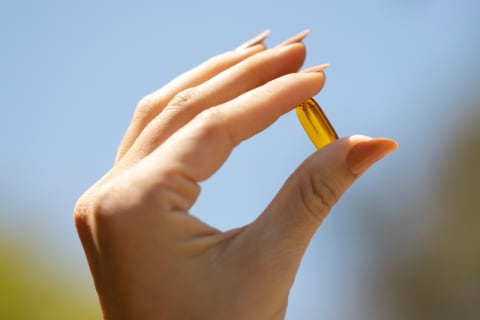Advertisement
Doctors Thought It Was All In My Head – Until I Was Finally Diagnosed With An Autoimmune Disease


I was 24, two years out of college, living in San Francisco with my friends, climbing the corporate ranks as a product manager, and healthy—until it all changed.
I set off on a hiking trip with my dad to climb Half Dome in Yosemite (not our first rodeo). But the day after we got back, I suddenly fainted, struggled to breathe and was rushed to the ER. They took a battery of tests all of which would come back as normal. I was sent home to begin a years-long journey that was anything but “normal.”
My wide-ranging symptoms began to take over my life
It started with intense fatigue and joint stiffness that impacted my ability to carry out even the most basic tasks—brushing my teeth, washing my hair, and typing on a computer were exhausting and painful. It was followed by my hair falling out and strange skin rashes. I would become uncomfortably bloated no matter what I ate. Intense headaches and chest pains were the daily norm. I regularly struggled with blurry vision, difficulty balancing, and debilitating brain fog to the point I couldn’t remember friends’ names or how to get back to my apartment from work.
These symptoms would hit me in waves—intensifying for weeks at a time only to eventually subside. The “good” periods were plagued with anxiety while I braced for the “bad” – which often left me unable to work and completely bedridden. One of my worst episodes sent me (back) to the ER. This time I was experiencing intense, uncontrollable tremors. They sent me home with painkillers and a psychiatric referral for my attention-seeking “symptoms”.
I was terrified I was dying but at the same time, I began to question if the pain I was experiencing was even real.
It wasn’t until I shelled out hundreds of dollars to see a functional medicine doctor that my journey changed course. I was met with empathy and curiosity rather than dismissals and specialist referrals. I spent two hours with my practitioner where she asked me questions that looked at me as a whole person, not a set of symptoms. She ordered a set of specialty labs that looked at underlying root causes and identified optimal ranges instead of what’s defined as “normal.” And, for the first time, I got an answer.
I was on the subway platform waiting for my train when it came: I had a positive ANA, an antinuclear antibody—one of the hallmark signs of autoimmune disease.
Autoimmune disease is a group of over 100 conditions—which includes lupus, rheumatoid arthritis, and type 1 diabetes, to name a few—which are caused when our immune system turns on us, mistakenly attacking healthy cells. Autoimmune diseases can affect any system in the body, and their symptoms vary widely, making them difficult to diagnose.
In my case, it took 11 doctors, two ER trips, 12 blood draws, three trips to urgent care, and two years to get this diagnosis – and that’s only because I had access.
Armed with answers, I was determined to help other women
I felt waves of emotions (fear, relief, validation) before anger set in. My years-long mysterious condition was a full-fledged epidemic affecting 1 in 5 Americans, and I wanted to shout it from the rooftops so others wouldn’t have to go through this, too.
New to TikTok, I posted a video about the symptoms I was told were “normal” that turned out to be signs of autoimmune disease. To my shock, it racked up millions of views in a matter of hours, and thousands of comments from women reaching out with eerily similar experiences.
Search #autoimmunedisease on TikTok and you’ll get a very real and terrifying snapshot of this epidemic’s stronghold on women in America: over 1.1B video views, and countless thumbnails featuring the faces of twenty- and thirty-somethings just like me. We’re turning to TikTok for the autoimmune support our medical system isn’t giving us.
The autoimmune epidemic disproportionately wreaks havoc on women – 80% of patients are women1, and certain conditions are 16 times more common1 in women. They are one of the top 10 causes of death for women under 64. Despite all of this, autoimmune disease remains largely overlooked and misdiagnosed by healthcare professionals. On average, we have to see 5 different doctors and wait nearly half a decade before receiving the correct diagnosis. Almost half of us are told our symptoms are all in our head at some point along the way.
It was no coincidence when my sister, Claire, was diagnosed with autoimmune disease months later. She had similar, hard-to-pinpoint symptoms, normal labs, and dismissals from various doctors.
Getting healthy again quickly became a full-time job for both of us. We threw ourselves into learning everything there was to know about these diseases, and what evidence-based interventions would bring us the most relief. As we dove into the research, it became abundantly clear how underserved our community was and how desperately we needed better support and tools. So we decided to team up and left our full-time jobs to fill the major systemic gaps that exist in today’s standard of care.
Last year, we launched a virtual care platform called WellTheory to help women shortcut, and ultimately improve, the current path to an autoimmune diagnosis and receiving care. Our goal is to increase access to high-quality autoimmune care – making it affordable, empathetic, empowering, effective, and what we so desperately needed from the beginning.
But WellTheory is just one piece of the equation to reversing autoimmune disease. More broadly, it takes arming women with the resources to navigate the under researched and overlooked health issues that affect us the most – from fertility and menopause to autoimmune disease and beyond.
What I hope people can take away from my story
I want every woman – with or without autoimmune disease – to know what I wish I knew sooner.
First of all, you are the world’s best expert on your body. I found that many providers often dismissed me because these invisible and ambiguous symptoms are hard to pinpoint. It’s challenging because our bodies are under-researched, and our society often teaches us to look outside of our own lived experience for validation and answers. There’s really no one-size-fits-all path to healing, so seek guidance externally, but look internally to decide what’s right for you. Don’t forget: your body knows best—listen to it and advocate for yourself.
On that note, there is a lot within our control outside of the doctor’s office. While many of us know that excess alcohol, fried foods, and all-nighters wreak havoc on our bodies, there are also other influential lifestyle factors that often go overlooked—like how we manage stress, our environmental exposures and the quality of our relationships. Through trial and error, I realized that there were certain foods that were big triggers for me, and that eating an anti-inflammatory diet helped keep my flare-ups at bay. I also looked at my surroundings and learned that my apartment was riddled with mold. My symptoms dissipated as soon as I left.
Lastly, I’ve found it so essential to foster a community. Navigating an autoimmune diagnosis can take many years and can often be an incredibly lonely journey. And once you’re diagnosed, there’s a real grieving process where you might mourn your past life. Not to mention, the process of learning how to manage your disease can be very isolating as well, especially if you’re making changes to your lifestyle that might be different from your friends and family. What I’ve found is that having a built-out support system to lean on is really critical for enduring the highs and lows of your health journey. Connection to others is critical for the healing process. For me, I found incredible strength in TikTok and the 75K other individuals navigating autoimmune disease alongside me.
